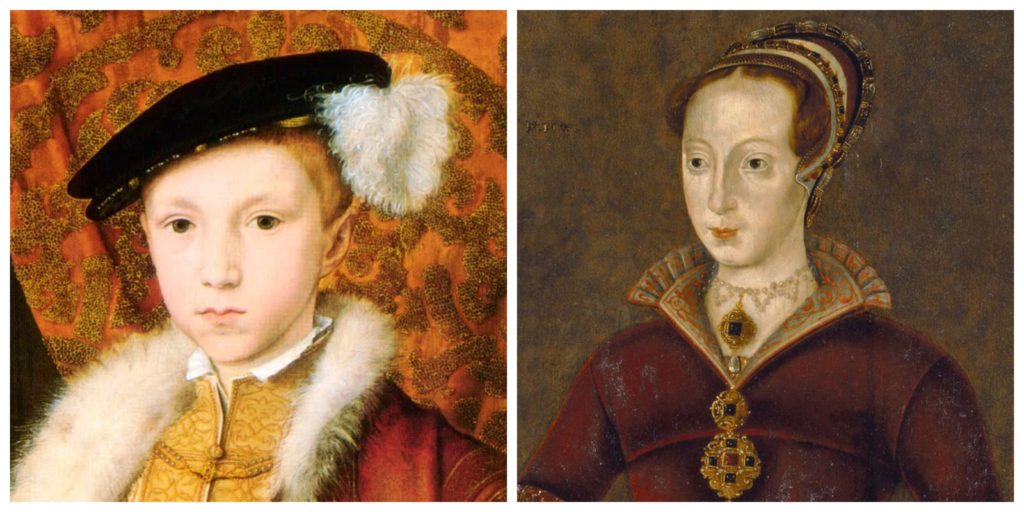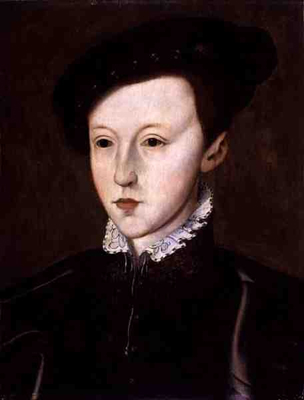On the 6th of July 1553, King Edward VI died at Greenwich Palace. The only surviving son of Henry VIII and his third wife, Jane Seymour, he breathed his last at the age of fifteen, dying from consumption. John Foxe’s account of his death states that Edward’s last words were:
“I am faint; Lord have mercy upon me, and take my spirit.”
What would England have been like during Edward’s reign if he had not died so young? Would the Tudor dynasty have ended just at the beginning of the 17th century? Would Henry VIII’s son have eventually become a tyrannical and narcissistic sociopath, like his famous father? Would the kingdom have prospered during his reign? What would have happened in the religious field?
King Edward VI, Henry VIII’s son with Jane Seymour
If Edward had survived or if he had not fallen ill at all, there was a good chance that the Tudor dynasty would not have died out. No doubt teenaged Edward would have married eventually, most likely sooner than later. Remembering his father’s struggle for a male heir, Edward must have believed that his mission was to prevent the crisis of succession. Over the course of time, he could have taken even several wives if he had faced the same problem his father had done – to sire a healthy son so as to secure the Tudor dynasty’s future.
A suitable match for Edward would have been a German, Danish, or Swedish Protestant princess. Marrying into the Houses of Habsburg or Valois was an option, but the monarch was a staunch Protestant. In childhood, Edward had been betrothed to Mary Stuart, Queen of Scots, but at the time of his death, she was betrothed to Dauphin François. Mary could have married Edward after her return to Scotland following the death of François II, but it does not seem likely. Edward could have wed an English noblewoman: he seems to have been fond of his cousin, Lady Jane Grey. 
Edward VI and his cousin, Lady Jane Grey
Would Edward VI have become a tyrannical, narcissistic ruler, like Henry VIII? We cannot say so for a certainty because many factors would have influenced his character at various stages of his life. Edward received the best education of the golden Tudor prince, having studied Erasmus, Cicero, Herodotus, and Plutarch, as well as theology, rhetoric, languages, mathematics, and astronomy. Educated and intelligent, young Edward was sparely built, with lean inquisitive features and alert, clever eyes. On his portraits, Edward appears to have had the Tudor red-gold hair, but he did not possess a robust constitution, unlike Henry VIII. Nevertheless, on his portraits, he attempted to make his appearance as majestic as his father’s.
Edward liked appearing before his courtiers in magnificent clothes for pomp. In October 1551, Marie de Guise visited the English court on the way to France to meet with her daughter, Mary Stuart; she commented that Edward had put on a great show to impress her. Although the court of a Renaissance ruler was usually lavish, it could be a sign of the similarity of Edward’s tastes to his father’s opulent tastes. Henry VIII’s court was rightly famed for its luxury, so Edward could have continued his parent’s extravagant lifestyle.
Remarkably, King Edward VI was capable of sending his own relatives to death. One of the king’s uncles – Thomas Seymour – was arrested and charged with treason, and Edward himself gave the Privy Council permission to have his uncle beheaded in 1549. Later, however, Edward Seymour, also the king’s uncle, lost his role of lord protector and followed in his younger brother’s footsteps – he was executed in 1552. According to his private journal, Edward VI viewed the deaths of his relatives as usual royal business, so he could be as ruthless as his father was.
Edward may have been a great Renaissance king ruling England wisely and prudently, but he was still Henry VIII’s son. He had been raised with the knowledge that one day, he would become King of England and the Supreme Head of the Church of England. So, from his early youth, Edward was accustomed to the idea of him possessing and exercising absolute power. Over time, he could have developed a narcissistic personality disorder, just as it seems to have happened to Henry VIII.
Although the religious reform had started with England’s break from Rome, Henry VIII remained a Catholic at heart. However, Edward was a devout Protestant, whose religious education was highly influenced by Archbishop Thomas Cranmer. Edward aimed to turn England into a Protestant nation, and he largely succeeded, despite his short reign. The Church had been transformed into a recognizable Protestant body; the clerical celibacy and the Mass had been abolished; the English Prayer Book and the Act of Uniformity, mandatory for the clergy, had been issued.
The First Book of Common Prayer in 1549
In history, Queen Elizabeth I was quite tolerant for her time, and harsh religious persecution took place only when certain religious groups threatened the peace in England and more importantly, the queen’s safety. I think that if Edward had not perished young, he would not have been as religiously tolerant to Catholics as his sister, Elizabeth, was. In my opinion, under Edward’s influence, Anglicanism could have morphed into a religion more Lutheran or Calvinist in its nature and procedures. There would have been no the Elizabethan Religious Settlement.
Edward’s relationship with his elder sister, Mary Tudor, was strained because of her fervent Catholic beliefs. During her brother’s reign, she preferred to live in the shadows, staying in her estates and rarely visiting court. Mary continuously refused Edward’s demands to forsake Catholicism. If the king had lived longer, the confrontation between the siblings would have been inevitable. Having executed his uncles, Edward could have signed Mary’s death warrant. But if he had lived many more years, Edward would have outlived his half-sister, so there would have been no “Bloody Mary”.
If the monarch had not passed away, Elizabeth Tudor’s life would have gone differently. Her brother would probably have used Elizabeth as a tool and pawn to establish new political alliances, but, unwilling to ever marry, she would have fought tooth and nail against any suitor. But if Edward’s own wife had not produced any surviving issue, then Elizabeth would have become his heir.
With King Edward VI on the throne, there could have been no England’s explorations in the New World. What if Edward had not been interested in the mysterious overseas lands? Then, nowadays the U.S. could be a different place if only the French or Spanish colonists had settled down there. Without Elizabeth I, the English might have been confined to their foggy island while Spain and Portugal divided the world between them. The colonial expansion in the Elizabethan era laid the foundation for the formation of the British Empire in later centuries.
If there had been no the illustrious Queen Elizabeth I of England, it would have been a very sad thing for all of us. But time cannot be turned back, so we cannot alter Edward VI’s fate, and we can only speculate about what-if scenarios.
All images are in the public domain.
Text © 2019 Olivia Longueville






